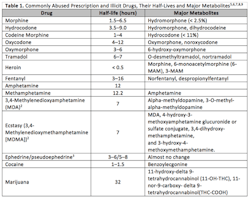Illicit Drug Impacts
About the author:
Heather Jennings is senior project engineer for Probiotic Solutions at Bio Huma Netics Inc. Jennings can be reached at [email protected].
I was attending a wastewater conference and overheard an operator talking about how a drug bust turned his lagoon orange and almost put him out of compliance with his permit. At another location, I was told that the city I was visiting had been hit by an unexpected source of ammonia that almost wiped out its bugs. I asked an operator if it was possible that the influent to his wastewater system might have illicit drugs in it. His reply was that although he frequently found drug paraphernalia in his screens, he didn’t know that any illicit drugs were present in his system. So I started wondering what impacts illicit drugs really have on wastewater systems, and I found some interesting results.
How Do You Know if You Have Illicit Drugs in Your System?
It has been historically documented that existing wastewater treatment plants (WWTPs) vary in the percentage reduction they can accomplish, ranging from 20 to 80%, when dealing with pharmaceuticals and personal care products (PPCPs). This is simply due to the fact that many of these WWTPs were not specifically designed to handle PPCPs, but, over time, more and more plants are being forced to deal with them. Effluent disposal into surface waters has been considered the largest contributor of PPCPs and micropollutants to surface water. This issue is not just a U.S. problem: Targeted investigative studies conducted in the U.K., the U.S. and Australia have shown that concentrations of pharmaceuticals in surface water and groundwater sources impacted by wastewater discharges are detectable—although at typically less than 0.1 µg/L (or 100 ng/L). The impact that these concentrations have is dependent on the toxicity of each drug and requires further study. In addition to PPCPs, wastewater plants now are more consistently dealing with the added stress of not only additional recreational drug use, but also the impact of illegal drug production, or “labs,” and their cleanup.
There are several ways in which commonly abused and illicit drugs make their way into wastewater systems. Unless the drugs or drug-making ingredients are directly flushed into the sewer, human users typically utilize the drug, metabolize it and then eliminate it into wastewater systems. These forms of the drugs are called “metabolites,” and each has its own half-life. For the purposes of this article, half-life is defined as how long it takes for half the dose to be eliminated from the bloodstream through the kidneys or liver. When testing wastewater, analytical chemists look for urinary biomarkers—measurable characteristics to calculate population drug use—which can be the parent drug (i.e. the primary substance) or its urinary metabolites. Table 1 (page 10) lists just a few typical commonly abused and/or illicit drugs and their half-lives. Half-lives are important to understand in wastewater because many wastewater collection systems will deliver the metabolites to the wastewater plant within the first half-life. Illicit drugs and their drug-making ingredients also can be brought into wastewater systems through septic hauling and disposal.
Another method by which illicit drugs enter sewer systems is through police action against illicit drug labs and the resulting cleanup. During police action, chemicals sometimes are disposed by flushing them down toilets or pouring them down drains. The U.S. Environmental Protection Agency (EPA) has created a Voluntary Guidelines for Methamphetamine Laboratory Cleanup that recommends repeated wash-downs and cleanings of impacted surface areas that are then sent down the sanitary sewer or are captured in a septic system to be disposed of later. This means that potentially larger quantities of illicit drugs and their base chemicals can be sent down to community wastewater treatment plants after bulk chemical removal without the requirement of contacting wastewater treatment plant operators.
What Impact Does It Have on Your System? How Would You Know You Have the Problem?
The big question, though, is how these illicit drugs, metabolites and chemicals can impact the wastewater system. Large swings in pH due to acids and bases used to make drugs can negatively impact activated sludge plants and lagoons. Without mitigation, activated sludge plants can lose their balance between nitrification and denitrification that occurs at a pH between 7 and 8.5. Lagoons typically don’t have pH control available, but with warning, the operators can maintain higher wastewater volume in order to buffer the impact better and possibly extend the holding time to increase treatment. Increasing mixing and aeration, when possible, also can help mitigate the impact of pH swings in the influent. Drops in alkalinity also can occur with acid dumps; significant occurrences can stop the nitrification process that depends on alkalinity in the WWTP.
If there is a significant enough volume of high or low pH flow into either activated sludge or lagoons, biomass can die off. Wastewater that continues to look like untreated influent is an indication of dead or dying biomass in activated sludge. Odors also will naturally increase. Indicators of dying biomass in lagoons are similar, although the odors can be even stronger. Other indicators for activated sludge or lagoon systems are marginal changes in biochemical oxygen demand (BOD) and chemical oxygen demand (COD) levels, as well as nitrogen and phosphorous levels, between influent and effluent. A rapid increase in chlorine disinfection usage or incomplete disinfection with ultraviolet also can be an indicator of system upset.
Other chemicals used in drug-making that can impact wastewater treatment include anhydrous ammonia and ammonium nitrate. A large enough volume of either of these two chemicals can overwhelm the biomass in wastewater systems and potentially “take down,” or significantly reduce, wastewater treatment system effectiveness. Recovery from any of these issues then becomes a consideration of implementing biostimulants or bioaugmentation, or a combination of the two in severe cases, in addition to best management protocols.
In the article Occurrence and Potential Biological Effects of Amphetamine on Stream Communities, it was reported that amphetamines and methamphetamines suppressed aquatic life, including microbes. We can assume that these substances have the same effect on wastewater treatment systems, where drug quantities can be even greater. Chronic suppression, or “slowing down,” of microbes in wastewater systems can cause issues in overall treatment and effluent water quality. Some operational measures in activated sludge can assist in overcoming this slowdown, such as increasing mixed liquor suspended solids and/or aeration; however, lagoon systems without aeration can be severely impacted and might not meet permit limits for effluent quality. Excessive sludge buildup also can occur in lagoon systems that cannot maintain an active biomass. Once again, biostimulants or bioaugmentation—or a combination of the two—can help both types of systems recover much more quickly than simply waiting it out.
How to Monitor
In 2007, the European Monitoring Centre for Drugs and Drug Addiction (EMCDDA) created the first expert meeting on “Assessing Drugs in Wastewater,” a wastewater approach to drug epidemiology or sewer epidemiology in order to identify the impact and deposition of PPCPs and illicit drugs in the environment. In short, “sewer epidemiology” is a term that is used to refer to the method of using wastewater to study and analyze patterns, causes and effects of health and disease conditions in communities. EMCDDA’s first recommendation is data collection.
If you have a pretreatment program in place, you may already have ongoing data collection for pH, BOD/COD, total ammonia, total Kjeldahl nitrogen (TKN) and flow. In addition to this, consider taking 24-hour composite volume proportional sampling at manholes and other trouble areas in the wastewater system. For gravity collection systems, additional sampling may be required due to the lack of overall mixing in the lines. Lab tests can be performed to identify potential sources of commonly abused or illicit drugs, metabolites or their associated chemicals. Further data collection recommendations for these sampling systems and activated sludge include:
- Sewer line or indirect discharger wastewater: number/type of indirect dischargers; flow (million gallons per day), BOD5, COD, total suspended solids (TSS), TKN, NH3-N, total phosphorus (TP), pH;
- Activated sludge systems, returned activated sludge: TSS, volatile suspended solids, NH3-N, pH;
- Activated sludge systems, primary effluent: BOD5, COD, TSS, TP, TKN, NH3-N, pH; and
- Lagoons, influent and effluent: BOD5, COD, TP TKN, NH3-N.
Additional pH meters can be temporarily placed in branch lines to monitor pH swings (from 2 to 13) caused by larger quantities of drug-making material, such as ammonia and other acids and or bases. Dissolved-oxygen meters can be used to monitor oxygen drops in wastewater systems, indicating that more air is necessary to maintain treatment or that a suddenly increasing dissolved oxygen level may be due to biomass die-off. Sudden drops in alkalinity can be an indicator of an acidic slug of chemicals coming into the system.
Samples will need to be sent out for analysis for metabolites and organics. Typically, samples undergo the following steps: pH prep, filtration, solid phase extraction and quantification by tandem mass spectrometry. Refractory toxicity assessments might have to be performed if a spiked sample in the wastewater treatment plant has a higher toxicity in the effluent when tested. The goal is to determine the source of system toxicity (drugs) and establish pretreatment requirements that can be set to reduce the refractory toxicity contributed to the wastewater treatment system or remove the source of the toxicity. This information is important to wastewater system operators, as it allows them to take a proactive approach to wastewater treatment rather than a reactive and recovery approach.
Here’s what we can do about it. Operators and municipalities need to realize that their systems can be significantly impacted by commonly abused and illicit drugs. They also should understand that they are not alone. It is not just a U.S. problem: Other nations are struggling with these same issues. Developing a pretreatment program and enforcing existing programs for industrial and commercial users can be very useful in isolating locations within the collection systems into which chemicals can be dumped. Proactively adding pH meters into branch lines in areas where illegal dumping can occur will provide advance warning to WWTPs. When WWTP upgrades are considered, more sophisticated treatments such as membranes, mixed-bed bioreactors and tertiary treatment can reduce PPCPs and illicit drugs from leaving in the effluent. Additional sewer epidemiology lab testing also can be a valuable tool in identifying the locations of contaminant sources.
If pretreatment and upgrades are not possible, developing partnerships and notification protocols with local police departments and drug enforcement agencies may be the single most effective thing that wastewater operators can do to be alerted to potential impacts to wastewater systems and to more quickly and knowledgeably address potential upsets within their systems.
The occurrence and impact of commonly abused and illicit drugs in WWTPs is a problem that is likely to grow. Plant operators must be vigilant and prepared. Although not designed as such, WWTPs are the last line of defense in protecting our water resources from drug pollution.


